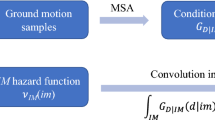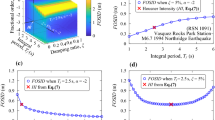Abstract
A probabilistic seismic demand modeling approach with the optimal intensity measure (IM) parameters determined a posteriori (POS-PSDM) is employed to examine and compare the full potential of the explanatory power of different IM formulations. A total of six IM formulations adopting the optimal IM parameters determined a posteriori (i.e. POS-IMs) are studied, including two spectral IMs with the optimal period T*, two fractional order IMs with the optimal fractional order α*, as well as two spectral IMs with the optimal period T* and the optimal damping ratio ζ*. A comprehensive IM comparative study is conducted based on hysteretic single-degree-of-freedom systems, considering a wide range of structural parameters. The POS-IMs manifest substantially improved performance (i.e. efficiency and sufficiency) compared with their conventional counterparts, revealing the value of adopting this POS-PSDM approach to ensure the PSDM predictive performance. In particular, the spectral acceleration at the optimal period and damping ratio, Sa(T*,ζ*), which is introduced as an IM candidate for the first time, not only consistently demonstrates superior explanatory power but also exhibits fairly good hazard computability. The POS-PSDM approach in conjunction with Sa(T*,ζ*) exhibits good potential in further improving the accuracy and reliability of probabilistic seismic risk assessment with negligible increase in computation cost.










Similar content being viewed by others
References
Akkar S, Bommer JJ (2007) Prediction of elastic displacement response spectra in Europe and the Middle East. Earthq Eng Struct Dyn 36:1275–1301
Akkar S, Özen Ö (2005) Effect of peak ground velocity on deformation demands for SDOF systems. Earthq Eng Struct Dyn 34:1551–1571
Akkar S, Sandıkkaya M, Ay B (2014) Compatible ground-motion prediction equations for damping scaling factors and vertical-to-horizontal spectral amplitude ratios for the broader Europe region. Bull Earthq Eng 12:517–547
Ancheta TD et al (2014) NGA-West2 database. Earthq Spectra 30:989–1005
Atkinson GM, Pierre J-R (2004) Ground-motion response spectra in eastern North America for different critical damping values. Seismol Res Lett 75:541–545
Baker JW, Cornell CA (2006) Spectral shape, epsilon and record selection. Earthq Eng Struct Dyn 35:1077–1095
Baker JW, Cornell CA (2008) Vector-valued intensity measures incorporating spectral shape for prediction of structural response. J Earthq Eng 12:534–554
Baker JW, Jayaram N (2008) Correlation of spectral acceleration values from NGA ground motion models. Earthq Spectra 24:299–317
Bianchini M, Diotallevi P, Baker J (2009) Prediction of inelastic structural response using an average of spectral accelerations. In: 10th international conference on structural safety and reliability (ICOSSAR09)
Bojorquez E, Iervolino I (2011) Spectral shape proxies and nonlinear structural response. Soil Dyn Earthq Eng 31:996–1008
Cameron WI, Green RA (2007) Damping correction factors for horizontal ground-motion response spectra. B Seismol Soc Am 97:934–960
Caputo M (1967) Linear models of dissipation whose Q is almost frequency independent—II. Geophys J Int 13:529–539
Cauzzi C, Faccioli E (2008) Broadband (0.05 to 20 s) prediction of displacement response spectra based on worldwide digital records. J Seismol 12:453
Chen Y, Yu Y-X (2008) The development of attenuation relations in the rock sites for periods (T = 0.04 ~ 10 s, ξ = 0.05) based on NGA database. In: Proceedings of fourteenth world conference on earthquake engineering
Cordova PP, Deierlein GG, Mehanny SS, Cornell CA (2000) Development of a two-parameter seismic intensity measure and probabilistic assessment procedure. In: The second US-Japan workshop on performance-based earthquake engineering methodology for reinforced concrete building structures, pp 187–206
Cornell CA, Krawinkler H (2000) Progress and challenges in seismic performance assessment. Peer Center News 20:130–139
Cornell CA, Jalayer F, Hamburger RO, Foutch DA (2002) Probabilistic basis for 2000 SAC federal emergency management agency steel moment frame guidelines. J Struct Eng 128:526–533
De Biasio M, Grange S, Dufour F, Allain F, Petre-Lazar I (2014) A simple and efficient intensity measure to account for nonlinear structural behavior. Earthq Spectra 30:1403–1426
Deierlein G, Krawinkler H, Cornell C (2003) A framework for performance-based earthquake engineering. In: Pacific conference on earthquake engineering. Citeseer, pp 1–8
Du A, Padgett JE, Shafieezadeh A (2018) Adaptive IMs for improved seismic demand modeling of highway bridge portfolios. In: The 11th national conference in earthquake engineering, Los Angeles, CA
Eads L, Miranda E, Lignos DG (2015) Average spectral acceleration as an intensity measure for collapse risk assessment. Earthq Eng Struct Dyn 44:2057–2073
Ebrahimian H, Jalayer F, Lucchini A, Mollaioli F, Manfredi G (2015) Preliminary ranking of alternative scalar and vector intensity measures of ground shaking. Bull Earthq Eng 13:2805–2840
Giovenale P, Cornell CA, Esteva L (2004) Comparing the adequacy of alternative ground motion intensity measures for the estimation of structural responses. Earthq Eng Struct Dyn 33:951–979
Goda K, Atkinson GM (2009) Probabilistic characterization of spatially correlated response spectra for earthquakes in Japan. B Seismol Soc Am 99:3003–3020
Gulkan P, Sozen MA (1974) Inelastic responses of reinforced concrete structure to earthquake motions. J Proc 71:604–610
Hatzigeorgiou GD (2010) Damping modification factors for SDOF systems subjected to near-fault, far-fault and artificial earthquakes. Earthq Eng Struct Dyn 39:1239–1258
Hubbard DT, Mavroeidis GP (2011) Damping coefficients for near-fault ground motion response spectra. Soil Dyn Earthq Eng 31:401–417
Iwan W (1980) Estimating inelastic response spectra from elastic spectra. Earthq Eng Struct Dyn 8:375–388
Jalayer F, Beck J, Zareian F (2011) Analyzing the sufficiency of alternative scalar and vector intensity measures of ground shaking based on information theory. J Eng Mech 138:307–316
Kale Ö, Padgett JE, Shafieezadeh A (2017) A ground motion prediction equation for novel peak ground fractional order response intensity measures. Bull Earthq Eng 15:3437–3461
Kowalsky MJ (1994) Displacement-based design-a methodology for seismic design applied to RC bridge columns. Master Thesis, University of California at San Diego, La Jolla, California
Lin Y-Y, Chang K-C (2004) Effects of site classes on damping reduction factors. J Struct Eng 130:1667–1675
Loh CH, Ho RC (1990) Seismic damage assessment based on different hysteretic rules. Earthq Eng Struct Dyn 19:753–771
Luco N, Cornell CA (2007) Structure-specific scalar intensity measures for near-source and ordinary earthquake ground motions. Earthq Spectra 23:357–392
Mahin SA, Lin J (1983) Construction of inelastic response spectra for single-degree-of-freedom systems. Rep No UCB/EERC-83 17
Miranda E (1993) Site-dependent strength-reduction factors. J Struct Eng 119:3503–3519
Mollaioli F, Liberatore L, Lucchini A (2014) Displacement damping modification factors for pulse-like and ordinary records. Eng Struct 78:17–27
Padgett JE, Nielson BG, DesRoches R (2008) Selection of optimal intensity measures in probabilistic seismic demand models of highway bridge portfolios. Earthq Eng Struct Dyn 37:711–725
Priestley M, Calvi GM, Kowalsky MJ (2007) Displacement-based seismic design of structures. IUSS Press, Pavia
Rezaeian S, Bozorgnia Y, Idriss I, Campbell K, Abrahamson N, Silva W (2012) Spectral damping scaling factors for shallow crustal earthquakes in active tectonic regions. Pacific Earthquake Engineering Research Center, Berkeley
Riddell R (2007) On ground motion intensity indices. Earthq Spectra 23:147–173
Riddell R, Hidalgo P, Cruz E (1989) Response modification factors for earthquake resistant design of short period buildings. Earthq Spectra 5:571–590
Rosenblueth E, Herrera I (1964) On a kind of hysteretic damping. J Eng Mech Div 90:37–48
Shafieezadeh A, Ramanathan K, Padgett JE, DesRoches R (2012) Fractional order intensity measures for probabilistic seismic demand modeling applied to highway bridges. Earthq Eng Struct Dyn 41:391–409
Shome N (1999) Probabilistic seismic demand analysis of nonlinear structures. Stanford University, Stanford
Stafford PJ, Mendis R, Bommer JJ (2008) Dependence of damping correction factors for response spectra on duration and numbers of cycles. J Struct Eng 134:1364–1373
Vamvatsikos D, Cornell CA (2005) Developing efficient scalar and vector intensity measures for IDA capacity estimation by incorporating elastic spectral shape information. Earthq Eng Struct Dyn 34:1573–1600
Xue D, Zhao C, Chen Y (2006) A modified approximation method of fractional order system. In: Proceedings of the 2006 IEEE international conference on mechatronics and automation. IEEE, pp 1043–1048
Acknowledgements
The insightful and helpful reviews of this manuscript from two anonymous reviewers are gratefully appreciated. The authors would like to acknowledge the support for this research by the National Science Foundation (NSF) through Grants CMMI-1462177 and CMMI-1462183. Any opinions, findings, and conclusions or recommendations expressed in this material are those of the authors and do not necessarily reflect the views of the National Science Foundation. The authors would also like to acknowledge the computational facilities provided by the Data Analysis and Visualization Cyberinfrastructure under NSF Grant OCI-0959097, the Big-Data Private-Cloud Research Cyberinfrastructure MRI-award under NSF Grant CNS-1338099 and Rice University.
Author information
Authors and Affiliations
Corresponding author
Electronic supplementary material
Below is the link to the electronic supplementary material.
Rights and permissions
About this article
Cite this article
Du, A., Padgett, J.E. & Shafieezadeh, A. A posteriori optimal intensity measures for probabilistic seismic demand modeling. Bull Earthquake Eng 17, 681–706 (2019). https://doi.org/10.1007/s10518-018-0484-8
Received:
Accepted:
Published:
Issue Date:
DOI: https://doi.org/10.1007/s10518-018-0484-8




